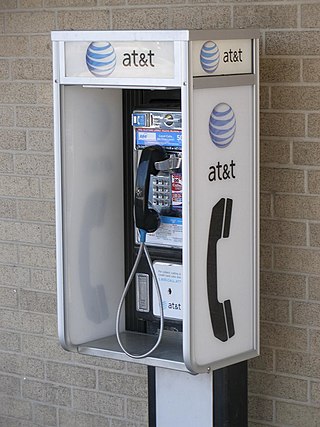
A payphone is typically a coin-operated public telephone, often located in a telephone booth or in high-traffic public areas. Prepayment is required by inserting coins or telephone tokens, swiping a credit or debit card, or using a telephone card.

The red telephone box, is a telephone kiosk for a public telephone designed by Sir Giles Gilbert Scott, the architect responsible for Liverpool Cathedral.

A jump start, also called a boost, is a procedure of starting a motor vehicle that has a discharged battery. A temporary connection is made to the battery of another vehicle, or to some other external power source. The external supply of electricity recharges the disabled vehicle's battery and provides some of the power needed to crank the engine. Once the vehicle has been started, its normal charging system will recharge, so the auxiliary source can be removed. If the vehicle charging system is functional, leaving the engine running will restore the charge of the battery.

A telephone booth, telephone kiosk, telephone call box, telephone box or public call box is a tiny structure furnished with a payphone and designed for a telephone user's convenience; usually the user steps into the booth and closes the booth door while using the payphone inside.
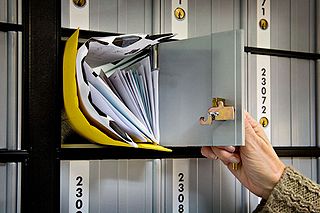
A post office box is a uniquely addressable lockable box located on the premises of a post office.

A newsagent's shop or simply newsagent's or paper shop, newsagency or newsstand is a business that sells newspapers, magazines, cigarettes, snacks and often items of local interest. In Great Britain, Ireland and Australia, these businesses are termed newsagents. Newsagents typically operate in busy public places like city streets, railway stations and airports. Racks for newspapers and magazines can also be found in convenience stores, bookstores and supermarkets. The physical establishment can be either freestanding or part of a larger structure.

An interactive kiosk is a computer terminal featuring specialized hardware and software that provides access to information and applications for communication, commerce, entertainment, or education.
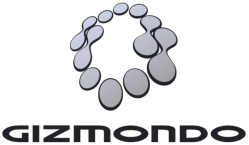
The Gizmondo is a handheld gaming console developed by Tiger Telematics. It was released in the UK, Sweden and the U.S. starting in March 2005. Its first-party games were developed in studios in Helsingborg, Sweden, and Manchester, England. Gizmondo Europe, Ltd. was based in London, England, and was a subsidiary of Florida-based Tiger Telematics, whose chairman Carl Freer led Gizmondo's development.
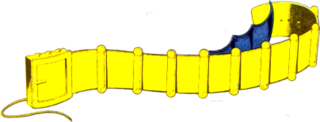
Batman's utility belt is a feature of Batman's costume. Similar belts are used by the various Robins, Batgirl, and other members of the Bat-family.
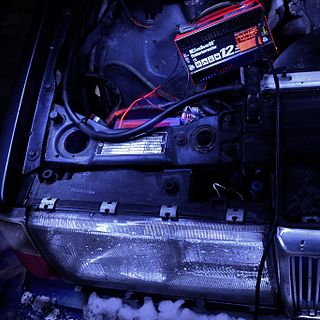
A battery charger, recharger, or simply charger, is a device that stores energy in an electric battery by running current through it. The charging protocol—how much voltage, current, for how long and what to do when charging is complete—depends on the size and type of the battery being charged. Some battery types have high tolerance for overcharging after the battery has been fully charged and can be recharged by connection to a constant voltage source or a constant current source, depending on battery type.

In telecommunications, a femtocell is a small, low-power cellular base station, typically designed for use in a home or small business. A broader term which is more widespread in the industry is small cell, with femtocell as a subset. It typically connects to the service provider's network via the Internet through a wired broadband link ; current designs typically support four to eight simultaneously active mobile phones in a residential setting depending on version number and femtocell hardware, and eight to sixteen mobile phones in enterprise settings. A femtocell allows service providers to extend service coverage indoors or at the cell edge, especially where access would otherwise be limited or unavailable. Although much attention is focused on WCDMA, the concept is applicable to all standards, including GSM, CDMA2000, TD-SCDMA, WiMAX and LTE solutions.

The HTC TyTN II is an Internet-enabled Windows Mobile Pocket PC smartphone designed and marketed by HTC Corporation of Taiwan. It has a tilting touchscreen with a right-side slide-out QWERTY keyboard. The TyTN II's functions include those of a camera phone and a portable media player in addition to text messaging and multimedia messaging. It also offers Internet services including e-mail, instant messaging, web browsing, and local Wi-Fi connectivity. It is a quad-band GSM phone with GPRS, EDGE, UMTS, HSDPA, and HSUPA.
TabletKiosk is a manufacturer of enterprise-grade Tablet PCs and UMPCs located in Torrance, California, United States. All mobile computers produced by TabletKiosk fall into the slate category, featuring touchscreen or pen input, in lieu of integrated or convertible keyboards. Current products include the Sahara Slate PC i500 series, designed in-house at TabletKiosk's Taiwan R&D facility. Early generations of the eo brand of UMPC were designed in collaboration with outside designers and the TabletKiosk team, while the fourth generation of this brand, the eo a7400 is designed exclusively in-house.

The Ericsson R290 is a combined GSM and satellite phone using the Globalstar satellite network. The R290 was introduced in June 1999 and manufactured in the United Kingdom by Ericsson Mobile Communications.

HTC Magic is an Android smartphone designed and manufactured by HTC. It is HTC's second Android phone after HTC Dream, HTC's first touch-only flagship Android device and the second Android phone commercially released, as well as the first Android phone without a keyboard.

MiFi is a brand name to describe a wireless router that acts as a mobile Wi-Fi hotspot device.

K-box was a small loudspeaker powered by an internal amplifier sold by Kerchoonz.com in 2009.

The Strawberry Tree is the world’s first public solar charger for mobile devices. It was developed by Serbian company Strawberry Energy. It won first place in the European Commission’s "Sustainable energy week 2011" competition in Brussels, in the category Consuming.
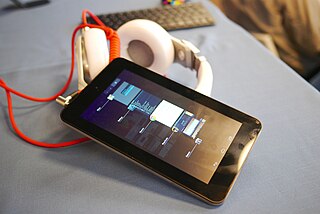
The HP Slate 7 is a 7-inch Android 4.1 tablet that was announced on February 24, 2013, and started shipping in April 2013. It has a stainless-steel frame, black front, and gray or red soft-touch back. A key feature of this small tablet is the microSDHC slot. It is HP's second Android device.

Hutchison 3G UK Limited, trading as Three UK, is a British telecommunications company based in Reading, England. It is an indirect, wholly-owned subsidiary of CK Hutchison Holdings, a limited liability Cayman Islands company registered and listed in Hong Kong. Three is the fourth-largest mobile network operator in the United Kingdom, with about 10.6 million subscribers as of May 2024.



















